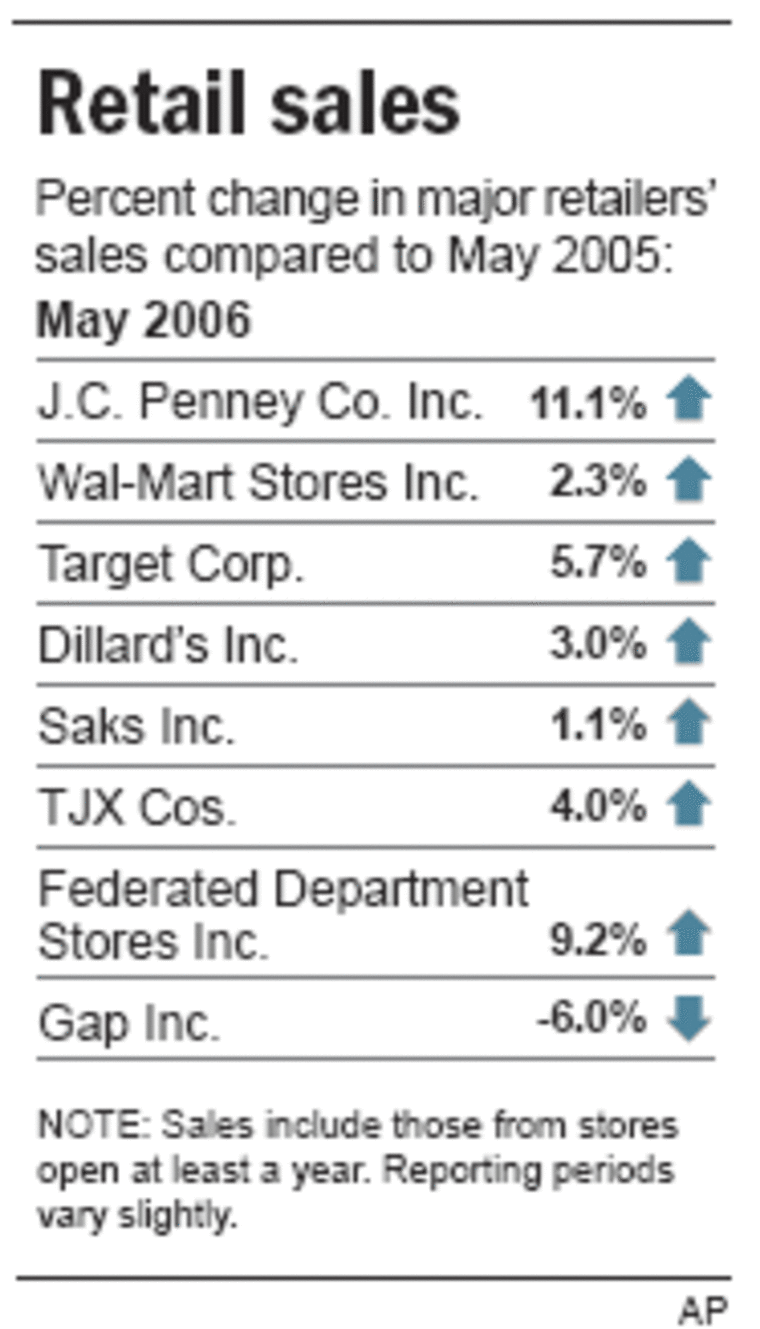Consumers apparently shook off their worries about higher gas prices during May, shopping with enthusiasm at apparel stores and malls and giving many retailers better-than-expected results. A big exception was Wal-Mart Stores Inc., whose low-income consumers are feeling the biggest financial squeeze from $3-a-gallon gas.
But the outlook for consumer spending remained uncertain as shoppers are faced with some big purchasing decisions: whether they should spend on summer vacations, for example, or buy more apparel and other items.
“The gas drag is a problem for some, but not a broad drag,” said Michael P. Niemira, chief economist at The International Council of Shopping Centers. But he predicted that amid mounting financial pressures, “there is likely going to be a second-half (consumer spending) slowdown.”
Donald Soares, principal of the consumer products group of Capgemini U.S. LLC, a consulting group, was more upbeat.
“Consumers do have the money to spend. And we see this trend continuing,” he said.

Based on sales reports released by the nation’s merchants Thursday, May’s winners cut across all sectors, included Target Corp., Federated Department Stores Inc. and J.C. Penney Co. Inc. Gap Inc. and Sharper Image Corp., which continue to struggle with their merchandising strategies, again were the laggards last month.
The International Council of Shopping Centers-UBS sales tally of 52 retailers rose 4.1 percent in May, better than the 3.2 percent gain expected. The tally is based on sales at stores opened at least a year, known as same-store sales. Same-store sales are considered the best indicator of a retailer’s health. May’s sales pace is in line with the 4.2 percent gain averaged from January through April.
While shoppers have remained resilient amid gasoline prices, the fear is that consumers will inevitably cut back their spending at malls and stores as the heavy summer driving season kicks into gear. Shoppers also face mounting pressures from higher interest rates, which make financing debt more expensive, as well as a cooling housing market.
Such economic headwinds are clearly making consumers more worried. The Conference Board said Tuesday that consumer confidence fell in May, suffering its steepest drop since the aftermath of Hurricanes Katrina and Rita last year.
Still, solid gains in the job market and rising wages have offset the pain at the pump for many customers, helping to prop up consumer spending. But that cushion could well evaporate as companies look for ways to cut labor costs as they battle higher energy costs and other expenses.
The Labor Department on Thursday reported that the number of newly laid off workers filing claims for unemployment benefits unexpectedly rose last week to 336,000. Even with the modest increase, the government is expected to show that nonfarm payrolls have added a healthy 170,000 jobs, up from a disappointing 138,000 job gain in April, when it releases monthly figures Friday. The unemployment rate should remain at 4.7 percent.
Wal-Mart is already starting to feel the pinch from higher gasoline prices. The discounter reported a 2.3 percent gain in same-store sales. Analysts surveyed by Thomson Financial expected a 2.9 percent gain in same-store sales.
“Fuel prices continue to be a top concern for our customers,” said Tom Schoewe, executive vice president and chief financial officer, in a statement. “We believe that our customers are consolidatig their store visits and focusing their spending on consumables — a trend that we have been seeing since Easter.”
To boost sales, Wal-Mart is trying to mimic rival Target’s strategy of appealing to its more upscale consumers with better quality and trendier apparel and electronics.
Meanwhile, Target had a 5.7 percent gain in same-store sales, better than the 4.8 percent estimate.
Apparel sellers, both department stores and specialty chains, did well, helped by some summer fashions like walking shorts, which can be worn to work, and lace tops.
Among department stores, Nordstrom had a 7.8 percent gain in same-store sales, beating the 4.2 estimate. Federated, which acquired May Department Stores Co. last year, had a same-store sales increase of 9.2 percent, better than the 5.3 percent forecast. Same-store sales include only Macy’s and Bloomingdale’s locations.
J.C. Penney enjoyed a 11.1 percent gain in same-store sales at its department stores, well exceeding the 2.0 percent estimate. The company also boosted its second-quarter earnings outlook.
Meanwhile, luxury operator Saks Inc. had a 1.1 percent gain in same-store sales, below the 2.6 percent estimate.
Limited Brands had a 7 percent gain in same-store sales, exceeding the 5.3 percent gain Wall Street anticipated.
AnnTaylor Stores Corp. posted a 12 percent gain in same-store sales, better than the 6.1 percent estimate.
But Gap had a 6 percent drop in same-store sales, worse than the 4.1 percent decline analysts forecast.
Gadget retailer Sharper Image, which continues to struggle, suffered a 36 percent drop in same-store sales, worse than the 21.5 percent decline projected by Wall Street.
Teen retailers had a mixed performance.
Abercrombie & Fitch had a 3 percent increase in same-store sales, in line with the 2.9 percent estimate. American Eagle Outfitters Inc., which reported Wednesday, enjoyed an 11 percent gain in same-store sales,exceeding the 9.3 percent estimate.
But both Pacific Sunwear of California Inc. and Hot Topic Inc. posted drops in same-store sales. Pacific Sunwear had a 2.6 percent decline in same-store sales, below the 3.5 percent estimate.
Hot Topic Inc. said Wednesday that it suffered a 6 percent drop in same-store sales, worse than the 5.1 percent decline that Wall Street expected.